Leadership and Change: Toyota and Ford - Detailed Report
VerifiedAdded on 2020/06/04
|12
|4001
|500
Report
AI Summary
This report delves into the change management strategies of Toyota and Ford, two major automotive companies. It examines the impact of internal and external drivers on organizational change, leadership, team dynamics, and individual behaviors. The report analyzes how these companies have adapted their strategies, including changes in improvement policies, leadership teams, and learning processes. It evaluates the negative impacts of change, such as financial constraints and potential decreases in productivity, and proposes measures to mitigate these challenges. The Burke-Litwin change model is highlighted as an effective framework for managing organizational change. The report also explores different leadership approaches to dealing with change, providing a comprehensive overview of change management in these global companies.
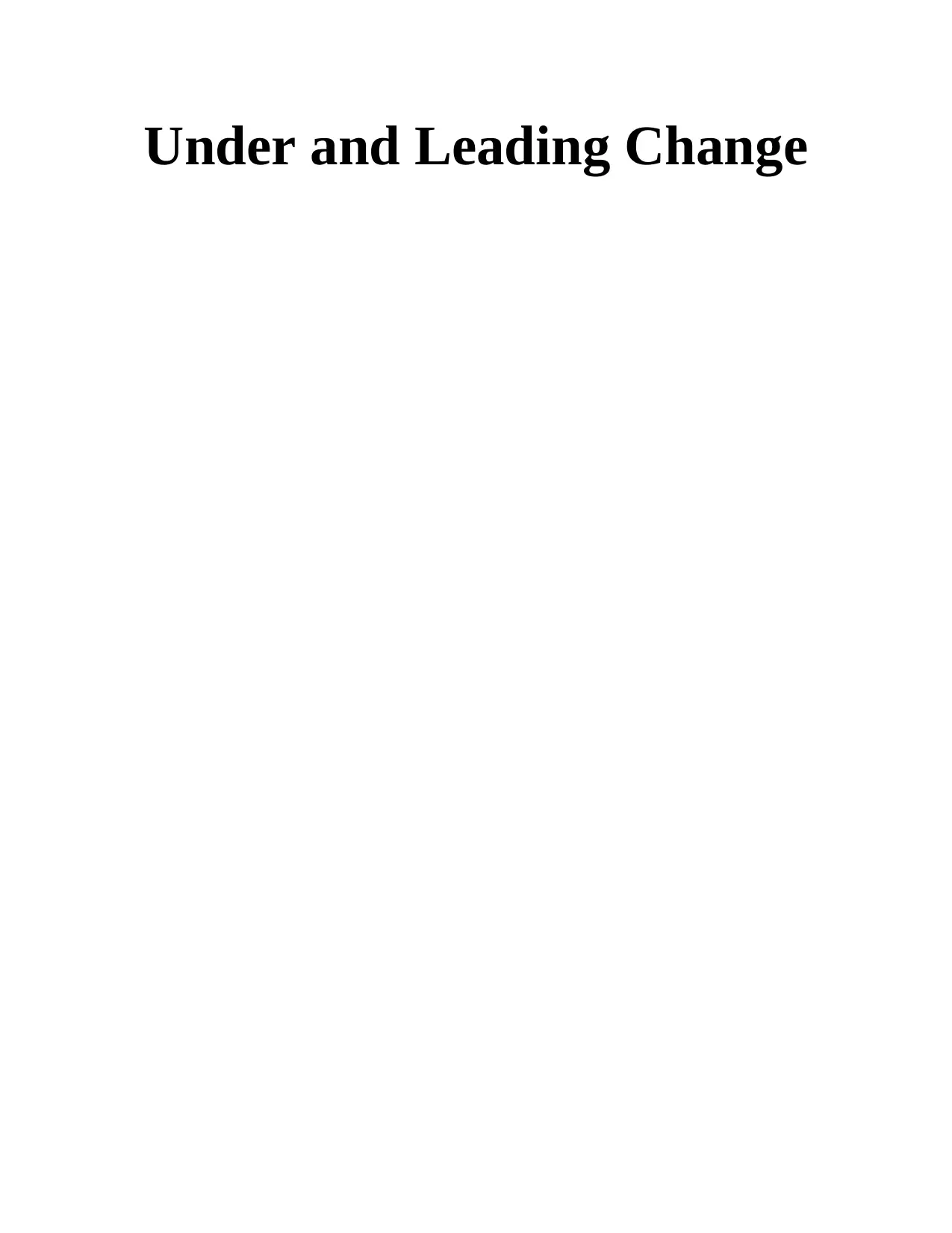
Under and Leading Change
Paraphrase This Document
Need a fresh take? Get an instant paraphrase of this document with our AI Paraphraser
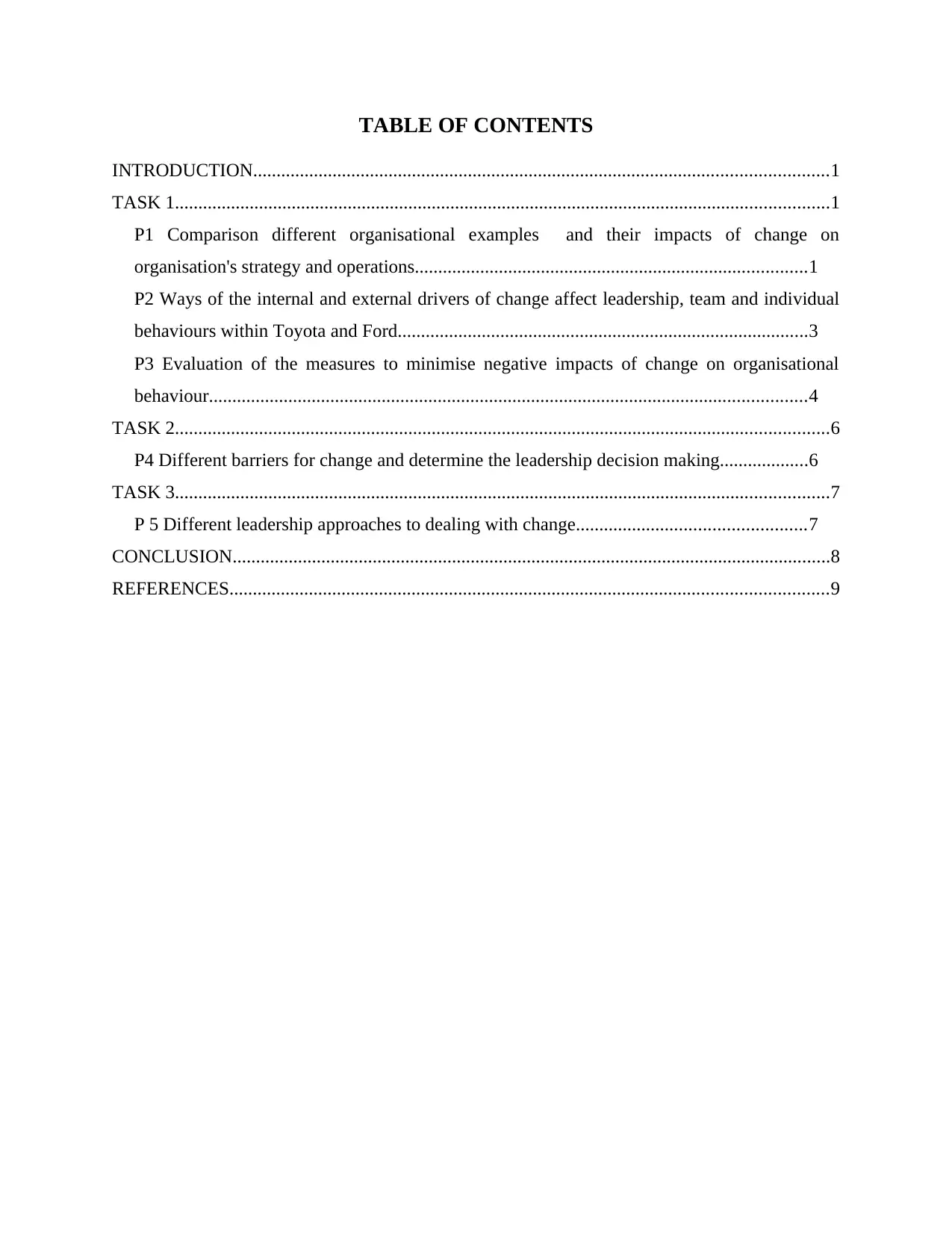
TABLE OF CONTENTS
INTRODUCTION...........................................................................................................................1
TASK 1............................................................................................................................................1
P1 Comparison different organisational examples and their impacts of change on
organisation's strategy and operations....................................................................................1
P2 Ways of the internal and external drivers of change affect leadership, team and individual
behaviours within Toyota and Ford........................................................................................3
P3 Evaluation of the measures to minimise negative impacts of change on organisational
behaviour................................................................................................................................4
TASK 2............................................................................................................................................6
P4 Different barriers for change and determine the leadership decision making...................6
TASK 3............................................................................................................................................7
P 5 Different leadership approaches to dealing with change.................................................7
CONCLUSION................................................................................................................................8
REFERENCES................................................................................................................................9
INTRODUCTION...........................................................................................................................1
TASK 1............................................................................................................................................1
P1 Comparison different organisational examples and their impacts of change on
organisation's strategy and operations....................................................................................1
P2 Ways of the internal and external drivers of change affect leadership, team and individual
behaviours within Toyota and Ford........................................................................................3
P3 Evaluation of the measures to minimise negative impacts of change on organisational
behaviour................................................................................................................................4
TASK 2............................................................................................................................................6
P4 Different barriers for change and determine the leadership decision making...................6
TASK 3............................................................................................................................................7
P 5 Different leadership approaches to dealing with change.................................................7
CONCLUSION................................................................................................................................8
REFERENCES................................................................................................................................9
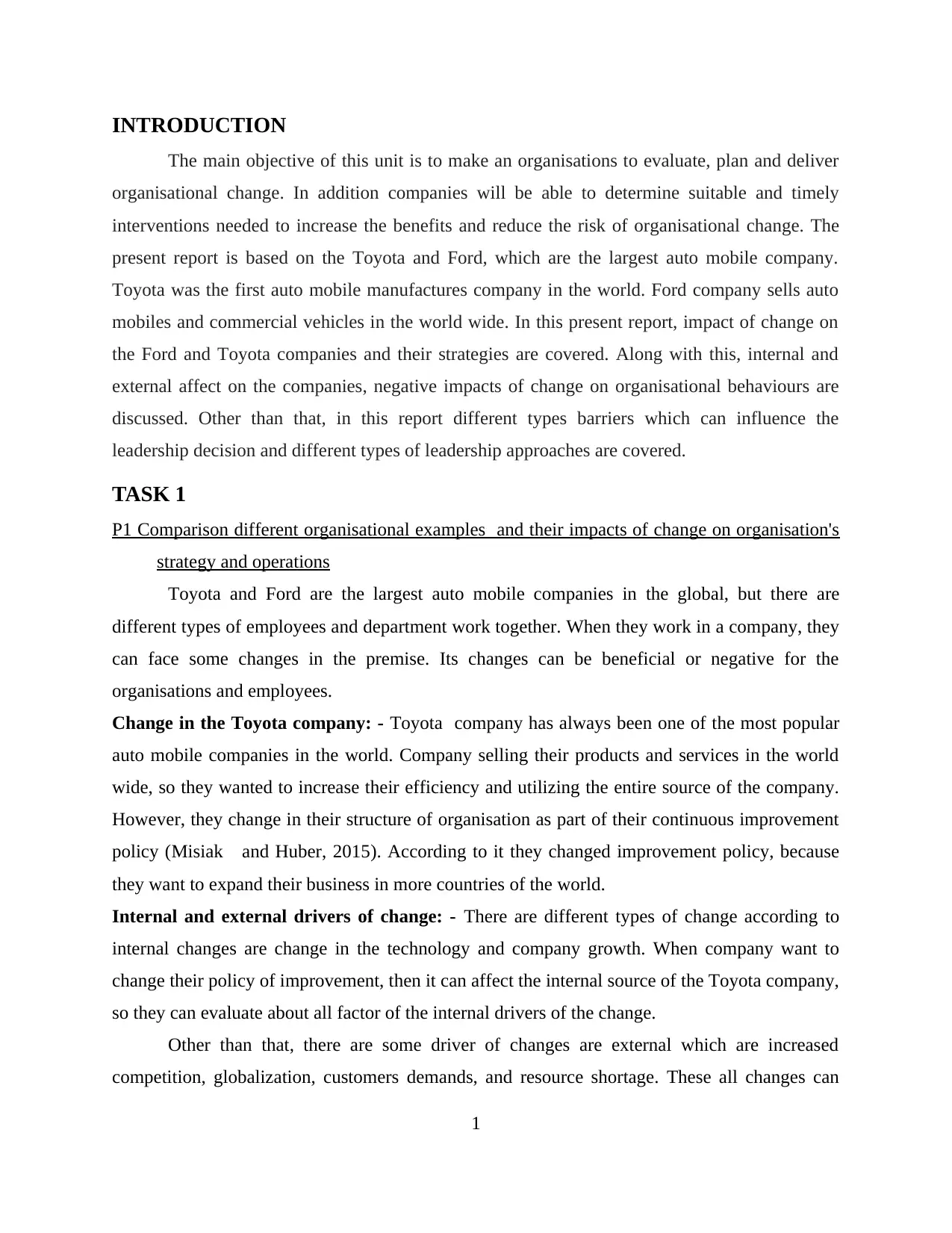
INTRODUCTION
The main objective of this unit is to make an organisations to evaluate, plan and deliver
organisational change. In addition companies will be able to determine suitable and timely
interventions needed to increase the benefits and reduce the risk of organisational change. The
present report is based on the Toyota and Ford, which are the largest auto mobile company.
Toyota was the first auto mobile manufactures company in the world. Ford company sells auto
mobiles and commercial vehicles in the world wide. In this present report, impact of change on
the Ford and Toyota companies and their strategies are covered. Along with this, internal and
external affect on the companies, negative impacts of change on organisational behaviours are
discussed. Other than that, in this report different types barriers which can influence the
leadership decision and different types of leadership approaches are covered.
TASK 1
P1 Comparison different organisational examples and their impacts of change on organisation's
strategy and operations
Toyota and Ford are the largest auto mobile companies in the global, but there are
different types of employees and department work together. When they work in a company, they
can face some changes in the premise. Its changes can be beneficial or negative for the
organisations and employees.
Change in the Toyota company: - Toyota company has always been one of the most popular
auto mobile companies in the world. Company selling their products and services in the world
wide, so they wanted to increase their efficiency and utilizing the entire source of the company.
However, they change in their structure of organisation as part of their continuous improvement
policy (Misiak and Huber, 2015). According to it they changed improvement policy, because
they want to expand their business in more countries of the world.
Internal and external drivers of change: - There are different types of change according to
internal changes are change in the technology and company growth. When company want to
change their policy of improvement, then it can affect the internal source of the Toyota company,
so they can evaluate about all factor of the internal drivers of the change.
Other than that, there are some driver of changes are external which are increased
competition, globalization, customers demands, and resource shortage. These all changes can
1
The main objective of this unit is to make an organisations to evaluate, plan and deliver
organisational change. In addition companies will be able to determine suitable and timely
interventions needed to increase the benefits and reduce the risk of organisational change. The
present report is based on the Toyota and Ford, which are the largest auto mobile company.
Toyota was the first auto mobile manufactures company in the world. Ford company sells auto
mobiles and commercial vehicles in the world wide. In this present report, impact of change on
the Ford and Toyota companies and their strategies are covered. Along with this, internal and
external affect on the companies, negative impacts of change on organisational behaviours are
discussed. Other than that, in this report different types barriers which can influence the
leadership decision and different types of leadership approaches are covered.
TASK 1
P1 Comparison different organisational examples and their impacts of change on organisation's
strategy and operations
Toyota and Ford are the largest auto mobile companies in the global, but there are
different types of employees and department work together. When they work in a company, they
can face some changes in the premise. Its changes can be beneficial or negative for the
organisations and employees.
Change in the Toyota company: - Toyota company has always been one of the most popular
auto mobile companies in the world. Company selling their products and services in the world
wide, so they wanted to increase their efficiency and utilizing the entire source of the company.
However, they change in their structure of organisation as part of their continuous improvement
policy (Misiak and Huber, 2015). According to it they changed improvement policy, because
they want to expand their business in more countries of the world.
Internal and external drivers of change: - There are different types of change according to
internal changes are change in the technology and company growth. When company want to
change their policy of improvement, then it can affect the internal source of the Toyota company,
so they can evaluate about all factor of the internal drivers of the change.
Other than that, there are some driver of changes are external which are increased
competition, globalization, customers demands, and resource shortage. These all changes can
1
⊘ This is a preview!⊘
Do you want full access?
Subscribe today to unlock all pages.

Trusted by 1+ million students worldwide
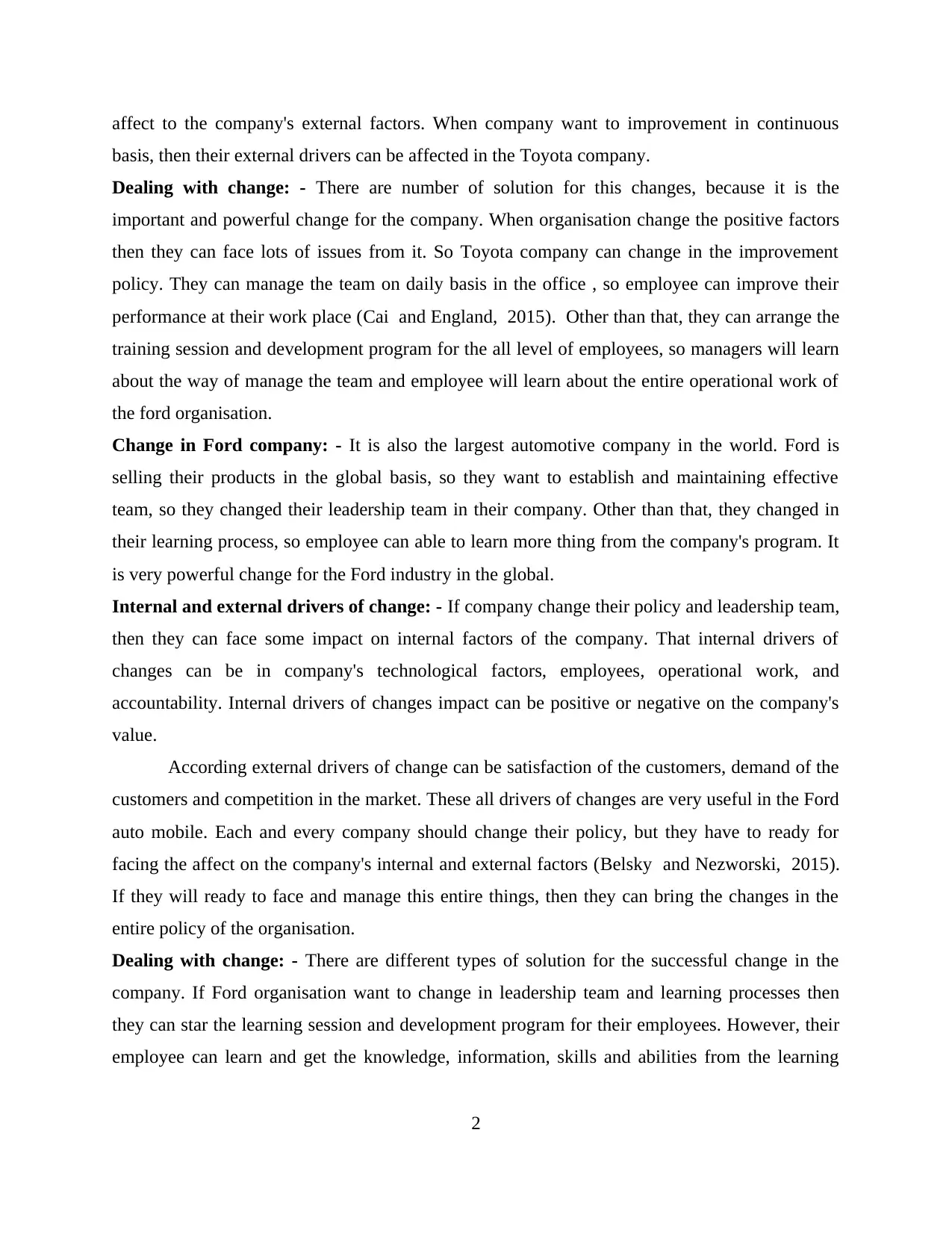
affect to the company's external factors. When company want to improvement in continuous
basis, then their external drivers can be affected in the Toyota company.
Dealing with change: - There are number of solution for this changes, because it is the
important and powerful change for the company. When organisation change the positive factors
then they can face lots of issues from it. So Toyota company can change in the improvement
policy. They can manage the team on daily basis in the office , so employee can improve their
performance at their work place (Cai and England, 2015). Other than that, they can arrange the
training session and development program for the all level of employees, so managers will learn
about the way of manage the team and employee will learn about the entire operational work of
the ford organisation.
Change in Ford company: - It is also the largest automotive company in the world. Ford is
selling their products in the global basis, so they want to establish and maintaining effective
team, so they changed their leadership team in their company. Other than that, they changed in
their learning process, so employee can able to learn more thing from the company's program. It
is very powerful change for the Ford industry in the global.
Internal and external drivers of change: - If company change their policy and leadership team,
then they can face some impact on internal factors of the company. That internal drivers of
changes can be in company's technological factors, employees, operational work, and
accountability. Internal drivers of changes impact can be positive or negative on the company's
value.
According external drivers of change can be satisfaction of the customers, demand of the
customers and competition in the market. These all drivers of changes are very useful in the Ford
auto mobile. Each and every company should change their policy, but they have to ready for
facing the affect on the company's internal and external factors (Belsky and Nezworski, 2015).
If they will ready to face and manage this entire things, then they can bring the changes in the
entire policy of the organisation.
Dealing with change: - There are different types of solution for the successful change in the
company. If Ford organisation want to change in leadership team and learning processes then
they can star the learning session and development program for their employees. However, their
employee can learn and get the knowledge, information, skills and abilities from the learning
2
basis, then their external drivers can be affected in the Toyota company.
Dealing with change: - There are number of solution for this changes, because it is the
important and powerful change for the company. When organisation change the positive factors
then they can face lots of issues from it. So Toyota company can change in the improvement
policy. They can manage the team on daily basis in the office , so employee can improve their
performance at their work place (Cai and England, 2015). Other than that, they can arrange the
training session and development program for the all level of employees, so managers will learn
about the way of manage the team and employee will learn about the entire operational work of
the ford organisation.
Change in Ford company: - It is also the largest automotive company in the world. Ford is
selling their products in the global basis, so they want to establish and maintaining effective
team, so they changed their leadership team in their company. Other than that, they changed in
their learning process, so employee can able to learn more thing from the company's program. It
is very powerful change for the Ford industry in the global.
Internal and external drivers of change: - If company change their policy and leadership team,
then they can face some impact on internal factors of the company. That internal drivers of
changes can be in company's technological factors, employees, operational work, and
accountability. Internal drivers of changes impact can be positive or negative on the company's
value.
According external drivers of change can be satisfaction of the customers, demand of the
customers and competition in the market. These all drivers of changes are very useful in the Ford
auto mobile. Each and every company should change their policy, but they have to ready for
facing the affect on the company's internal and external factors (Belsky and Nezworski, 2015).
If they will ready to face and manage this entire things, then they can bring the changes in the
entire policy of the organisation.
Dealing with change: - There are different types of solution for the successful change in the
company. If Ford organisation want to change in leadership team and learning processes then
they can star the learning session and development program for their employees. However, their
employee can learn and get the knowledge, information, skills and abilities from the learning
2
Paraphrase This Document
Need a fresh take? Get an instant paraphrase of this document with our AI Paraphraser
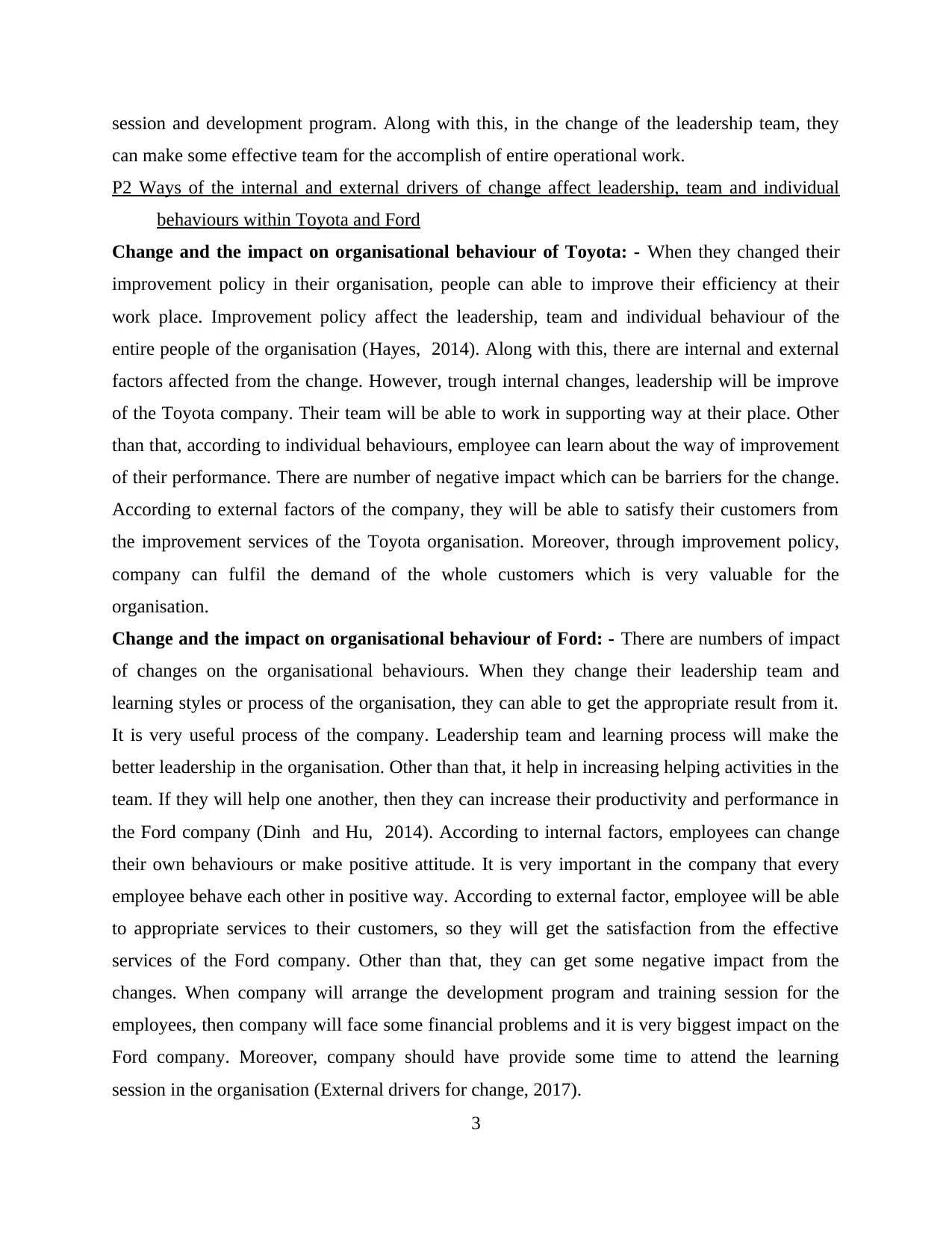
session and development program. Along with this, in the change of the leadership team, they
can make some effective team for the accomplish of entire operational work.
P2 Ways of the internal and external drivers of change affect leadership, team and individual
behaviours within Toyota and Ford
Change and the impact on organisational behaviour of Toyota: - When they changed their
improvement policy in their organisation, people can able to improve their efficiency at their
work place. Improvement policy affect the leadership, team and individual behaviour of the
entire people of the organisation (Hayes, 2014). Along with this, there are internal and external
factors affected from the change. However, trough internal changes, leadership will be improve
of the Toyota company. Their team will be able to work in supporting way at their place. Other
than that, according to individual behaviours, employee can learn about the way of improvement
of their performance. There are number of negative impact which can be barriers for the change.
According to external factors of the company, they will be able to satisfy their customers from
the improvement services of the Toyota organisation. Moreover, through improvement policy,
company can fulfil the demand of the whole customers which is very valuable for the
organisation.
Change and the impact on organisational behaviour of Ford: - There are numbers of impact
of changes on the organisational behaviours. When they change their leadership team and
learning styles or process of the organisation, they can able to get the appropriate result from it.
It is very useful process of the company. Leadership team and learning process will make the
better leadership in the organisation. Other than that, it help in increasing helping activities in the
team. If they will help one another, then they can increase their productivity and performance in
the Ford company (Dinh and Hu, 2014). According to internal factors, employees can change
their own behaviours or make positive attitude. It is very important in the company that every
employee behave each other in positive way. According to external factor, employee will be able
to appropriate services to their customers, so they will get the satisfaction from the effective
services of the Ford company. Other than that, they can get some negative impact from the
changes. When company will arrange the development program and training session for the
employees, then company will face some financial problems and it is very biggest impact on the
Ford company. Moreover, company should have provide some time to attend the learning
session in the organisation (External drivers for change, 2017).
3
can make some effective team for the accomplish of entire operational work.
P2 Ways of the internal and external drivers of change affect leadership, team and individual
behaviours within Toyota and Ford
Change and the impact on organisational behaviour of Toyota: - When they changed their
improvement policy in their organisation, people can able to improve their efficiency at their
work place. Improvement policy affect the leadership, team and individual behaviour of the
entire people of the organisation (Hayes, 2014). Along with this, there are internal and external
factors affected from the change. However, trough internal changes, leadership will be improve
of the Toyota company. Their team will be able to work in supporting way at their place. Other
than that, according to individual behaviours, employee can learn about the way of improvement
of their performance. There are number of negative impact which can be barriers for the change.
According to external factors of the company, they will be able to satisfy their customers from
the improvement services of the Toyota organisation. Moreover, through improvement policy,
company can fulfil the demand of the whole customers which is very valuable for the
organisation.
Change and the impact on organisational behaviour of Ford: - There are numbers of impact
of changes on the organisational behaviours. When they change their leadership team and
learning styles or process of the organisation, they can able to get the appropriate result from it.
It is very useful process of the company. Leadership team and learning process will make the
better leadership in the organisation. Other than that, it help in increasing helping activities in the
team. If they will help one another, then they can increase their productivity and performance in
the Ford company (Dinh and Hu, 2014). According to internal factors, employees can change
their own behaviours or make positive attitude. It is very important in the company that every
employee behave each other in positive way. According to external factor, employee will be able
to appropriate services to their customers, so they will get the satisfaction from the effective
services of the Ford company. Other than that, they can get some negative impact from the
changes. When company will arrange the development program and training session for the
employees, then company will face some financial problems and it is very biggest impact on the
Ford company. Moreover, company should have provide some time to attend the learning
session in the organisation (External drivers for change, 2017).
3
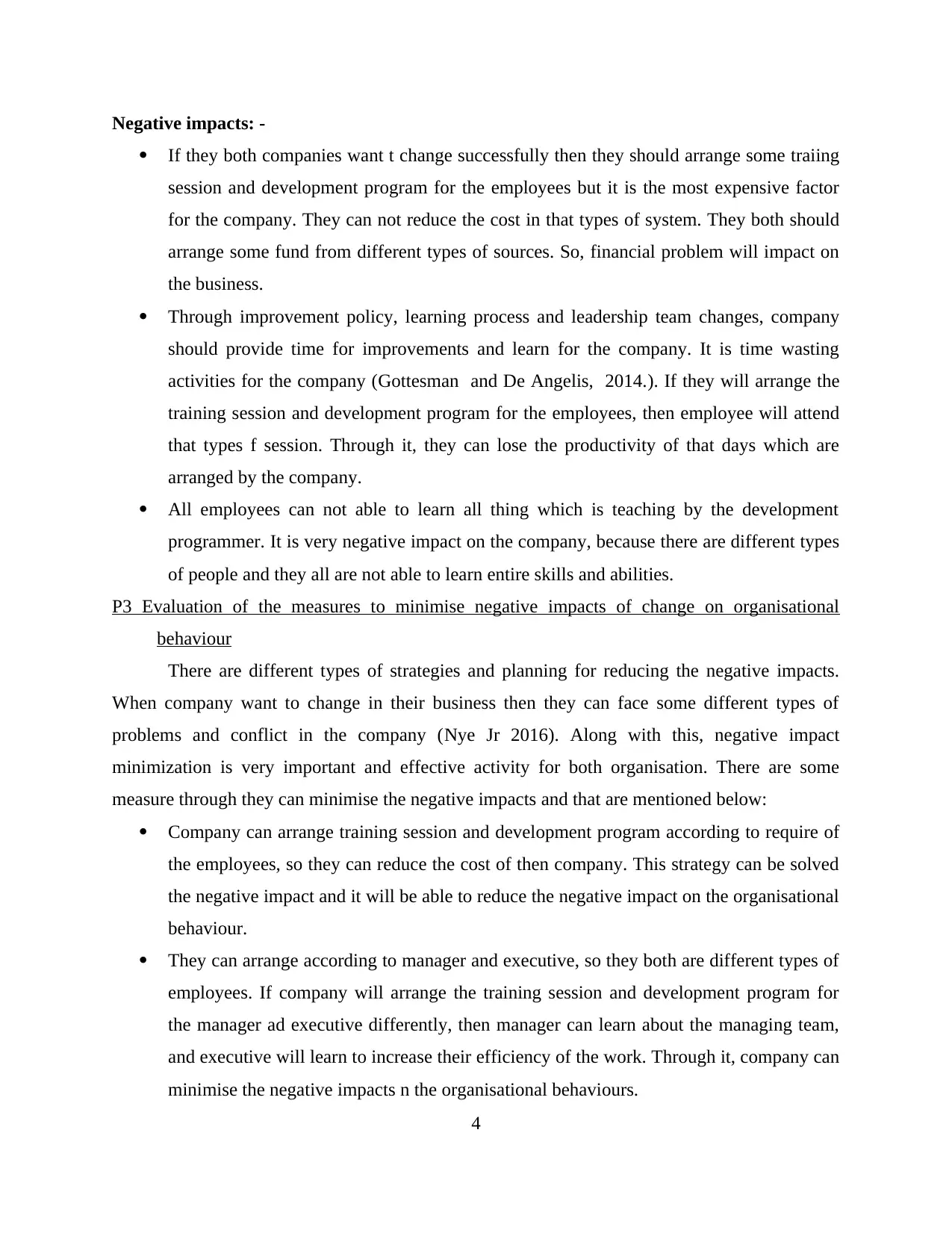
Negative impacts: -
If they both companies want t change successfully then they should arrange some traiing
session and development program for the employees but it is the most expensive factor
for the company. They can not reduce the cost in that types of system. They both should
arrange some fund from different types of sources. So, financial problem will impact on
the business.
Through improvement policy, learning process and leadership team changes, company
should provide time for improvements and learn for the company. It is time wasting
activities for the company (Gottesman and De Angelis, 2014.). If they will arrange the
training session and development program for the employees, then employee will attend
that types f session. Through it, they can lose the productivity of that days which are
arranged by the company.
All employees can not able to learn all thing which is teaching by the development
programmer. It is very negative impact on the company, because there are different types
of people and they all are not able to learn entire skills and abilities.
P3 Evaluation of the measures to minimise negative impacts of change on organisational
behaviour
There are different types of strategies and planning for reducing the negative impacts.
When company want to change in their business then they can face some different types of
problems and conflict in the company (Nye Jr 2016). Along with this, negative impact
minimization is very important and effective activity for both organisation. There are some
measure through they can minimise the negative impacts and that are mentioned below:
Company can arrange training session and development program according to require of
the employees, so they can reduce the cost of then company. This strategy can be solved
the negative impact and it will be able to reduce the negative impact on the organisational
behaviour.
They can arrange according to manager and executive, so they both are different types of
employees. If company will arrange the training session and development program for
the manager ad executive differently, then manager can learn about the managing team,
and executive will learn to increase their efficiency of the work. Through it, company can
minimise the negative impacts n the organisational behaviours.
4
If they both companies want t change successfully then they should arrange some traiing
session and development program for the employees but it is the most expensive factor
for the company. They can not reduce the cost in that types of system. They both should
arrange some fund from different types of sources. So, financial problem will impact on
the business.
Through improvement policy, learning process and leadership team changes, company
should provide time for improvements and learn for the company. It is time wasting
activities for the company (Gottesman and De Angelis, 2014.). If they will arrange the
training session and development program for the employees, then employee will attend
that types f session. Through it, they can lose the productivity of that days which are
arranged by the company.
All employees can not able to learn all thing which is teaching by the development
programmer. It is very negative impact on the company, because there are different types
of people and they all are not able to learn entire skills and abilities.
P3 Evaluation of the measures to minimise negative impacts of change on organisational
behaviour
There are different types of strategies and planning for reducing the negative impacts.
When company want to change in their business then they can face some different types of
problems and conflict in the company (Nye Jr 2016). Along with this, negative impact
minimization is very important and effective activity for both organisation. There are some
measure through they can minimise the negative impacts and that are mentioned below:
Company can arrange training session and development program according to require of
the employees, so they can reduce the cost of then company. This strategy can be solved
the negative impact and it will be able to reduce the negative impact on the organisational
behaviour.
They can arrange according to manager and executive, so they both are different types of
employees. If company will arrange the training session and development program for
the manager ad executive differently, then manager can learn about the managing team,
and executive will learn to increase their efficiency of the work. Through it, company can
minimise the negative impacts n the organisational behaviours.
4
⊘ This is a preview!⊘
Do you want full access?
Subscribe today to unlock all pages.

Trusted by 1+ million students worldwide
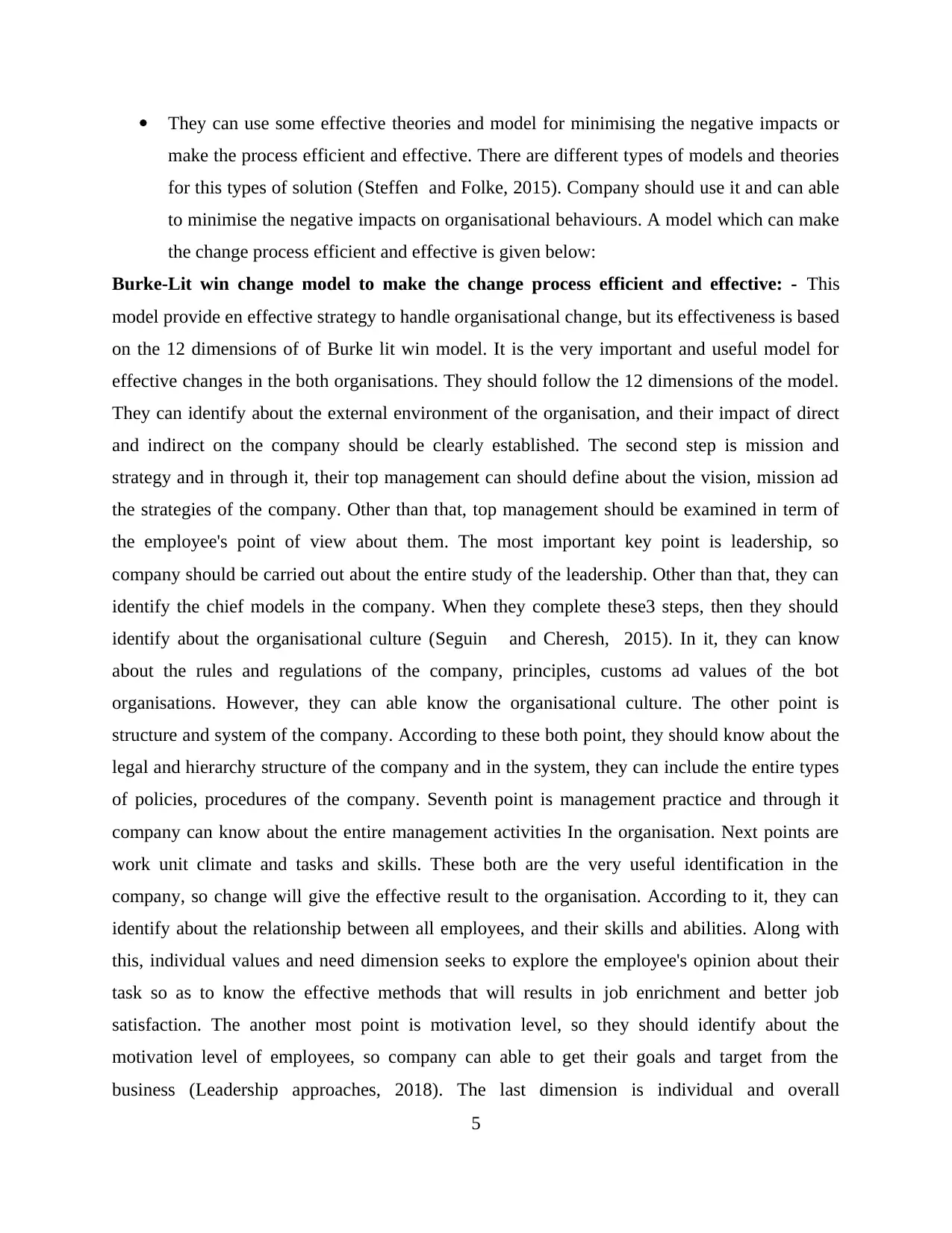
They can use some effective theories and model for minimising the negative impacts or
make the process efficient and effective. There are different types of models and theories
for this types of solution (Steffen and Folke, 2015). Company should use it and can able
to minimise the negative impacts on organisational behaviours. A model which can make
the change process efficient and effective is given below:
Burke-Lit win change model to make the change process efficient and effective: - This
model provide en effective strategy to handle organisational change, but its effectiveness is based
on the 12 dimensions of of Burke lit win model. It is the very important and useful model for
effective changes in the both organisations. They should follow the 12 dimensions of the model.
They can identify about the external environment of the organisation, and their impact of direct
and indirect on the company should be clearly established. The second step is mission and
strategy and in through it, their top management can should define about the vision, mission ad
the strategies of the company. Other than that, top management should be examined in term of
the employee's point of view about them. The most important key point is leadership, so
company should be carried out about the entire study of the leadership. Other than that, they can
identify the chief models in the company. When they complete these3 steps, then they should
identify about the organisational culture (Seguin and Cheresh, 2015). In it, they can know
about the rules and regulations of the company, principles, customs ad values of the bot
organisations. However, they can able know the organisational culture. The other point is
structure and system of the company. According to these both point, they should know about the
legal and hierarchy structure of the company and in the system, they can include the entire types
of policies, procedures of the company. Seventh point is management practice and through it
company can know about the entire management activities In the organisation. Next points are
work unit climate and tasks and skills. These both are the very useful identification in the
company, so change will give the effective result to the organisation. According to it, they can
identify about the relationship between all employees, and their skills and abilities. Along with
this, individual values and need dimension seeks to explore the employee's opinion about their
task so as to know the effective methods that will results in job enrichment and better job
satisfaction. The another most point is motivation level, so they should identify about the
motivation level of employees, so company can able to get their goals and target from the
business (Leadership approaches, 2018). The last dimension is individual and overall
5
make the process efficient and effective. There are different types of models and theories
for this types of solution (Steffen and Folke, 2015). Company should use it and can able
to minimise the negative impacts on organisational behaviours. A model which can make
the change process efficient and effective is given below:
Burke-Lit win change model to make the change process efficient and effective: - This
model provide en effective strategy to handle organisational change, but its effectiveness is based
on the 12 dimensions of of Burke lit win model. It is the very important and useful model for
effective changes in the both organisations. They should follow the 12 dimensions of the model.
They can identify about the external environment of the organisation, and their impact of direct
and indirect on the company should be clearly established. The second step is mission and
strategy and in through it, their top management can should define about the vision, mission ad
the strategies of the company. Other than that, top management should be examined in term of
the employee's point of view about them. The most important key point is leadership, so
company should be carried out about the entire study of the leadership. Other than that, they can
identify the chief models in the company. When they complete these3 steps, then they should
identify about the organisational culture (Seguin and Cheresh, 2015). In it, they can know
about the rules and regulations of the company, principles, customs ad values of the bot
organisations. However, they can able know the organisational culture. The other point is
structure and system of the company. According to these both point, they should know about the
legal and hierarchy structure of the company and in the system, they can include the entire types
of policies, procedures of the company. Seventh point is management practice and through it
company can know about the entire management activities In the organisation. Next points are
work unit climate and tasks and skills. These both are the very useful identification in the
company, so change will give the effective result to the organisation. According to it, they can
identify about the relationship between all employees, and their skills and abilities. Along with
this, individual values and need dimension seeks to explore the employee's opinion about their
task so as to know the effective methods that will results in job enrichment and better job
satisfaction. The another most point is motivation level, so they should identify about the
motivation level of employees, so company can able to get their goals and target from the
business (Leadership approaches, 2018). The last dimension is individual and overall
5
Paraphrase This Document
Need a fresh take? Get an instant paraphrase of this document with our AI Paraphraser
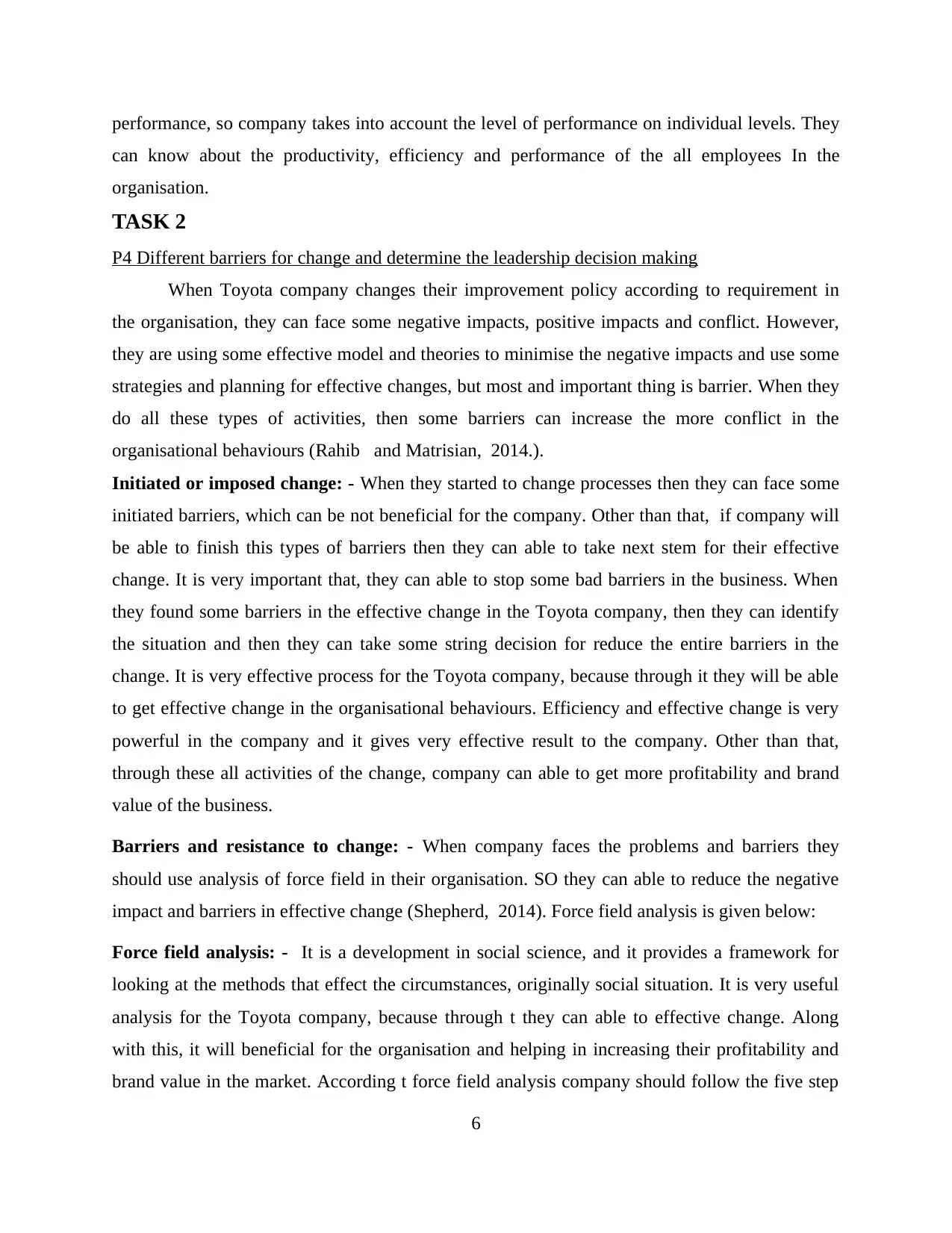
performance, so company takes into account the level of performance on individual levels. They
can know about the productivity, efficiency and performance of the all employees In the
organisation.
TASK 2
P4 Different barriers for change and determine the leadership decision making
When Toyota company changes their improvement policy according to requirement in
the organisation, they can face some negative impacts, positive impacts and conflict. However,
they are using some effective model and theories to minimise the negative impacts and use some
strategies and planning for effective changes, but most and important thing is barrier. When they
do all these types of activities, then some barriers can increase the more conflict in the
organisational behaviours (Rahib and Matrisian, 2014.).
Initiated or imposed change: - When they started to change processes then they can face some
initiated barriers, which can be not beneficial for the company. Other than that, if company will
be able to finish this types of barriers then they can able to take next stem for their effective
change. It is very important that, they can able to stop some bad barriers in the business. When
they found some barriers in the effective change in the Toyota company, then they can identify
the situation and then they can take some string decision for reduce the entire barriers in the
change. It is very effective process for the Toyota company, because through it they will be able
to get effective change in the organisational behaviours. Efficiency and effective change is very
powerful in the company and it gives very effective result to the company. Other than that,
through these all activities of the change, company can able to get more profitability and brand
value of the business.
Barriers and resistance to change: - When company faces the problems and barriers they
should use analysis of force field in their organisation. SO they can able to reduce the negative
impact and barriers in effective change (Shepherd, 2014). Force field analysis is given below:
Force field analysis: - It is a development in social science, and it provides a framework for
looking at the methods that effect the circumstances, originally social situation. It is very useful
analysis for the Toyota company, because through t they can able to effective change. Along
with this, it will beneficial for the organisation and helping in increasing their profitability and
brand value in the market. According t force field analysis company should follow the five step
6
can know about the productivity, efficiency and performance of the all employees In the
organisation.
TASK 2
P4 Different barriers for change and determine the leadership decision making
When Toyota company changes their improvement policy according to requirement in
the organisation, they can face some negative impacts, positive impacts and conflict. However,
they are using some effective model and theories to minimise the negative impacts and use some
strategies and planning for effective changes, but most and important thing is barrier. When they
do all these types of activities, then some barriers can increase the more conflict in the
organisational behaviours (Rahib and Matrisian, 2014.).
Initiated or imposed change: - When they started to change processes then they can face some
initiated barriers, which can be not beneficial for the company. Other than that, if company will
be able to finish this types of barriers then they can able to take next stem for their effective
change. It is very important that, they can able to stop some bad barriers in the business. When
they found some barriers in the effective change in the Toyota company, then they can identify
the situation and then they can take some string decision for reduce the entire barriers in the
change. It is very effective process for the Toyota company, because through it they will be able
to get effective change in the organisational behaviours. Efficiency and effective change is very
powerful in the company and it gives very effective result to the company. Other than that,
through these all activities of the change, company can able to get more profitability and brand
value of the business.
Barriers and resistance to change: - When company faces the problems and barriers they
should use analysis of force field in their organisation. SO they can able to reduce the negative
impact and barriers in effective change (Shepherd, 2014). Force field analysis is given below:
Force field analysis: - It is a development in social science, and it provides a framework for
looking at the methods that effect the circumstances, originally social situation. It is very useful
analysis for the Toyota company, because through t they can able to effective change. Along
with this, it will beneficial for the organisation and helping in increasing their profitability and
brand value in the market. According t force field analysis company should follow the five step
6
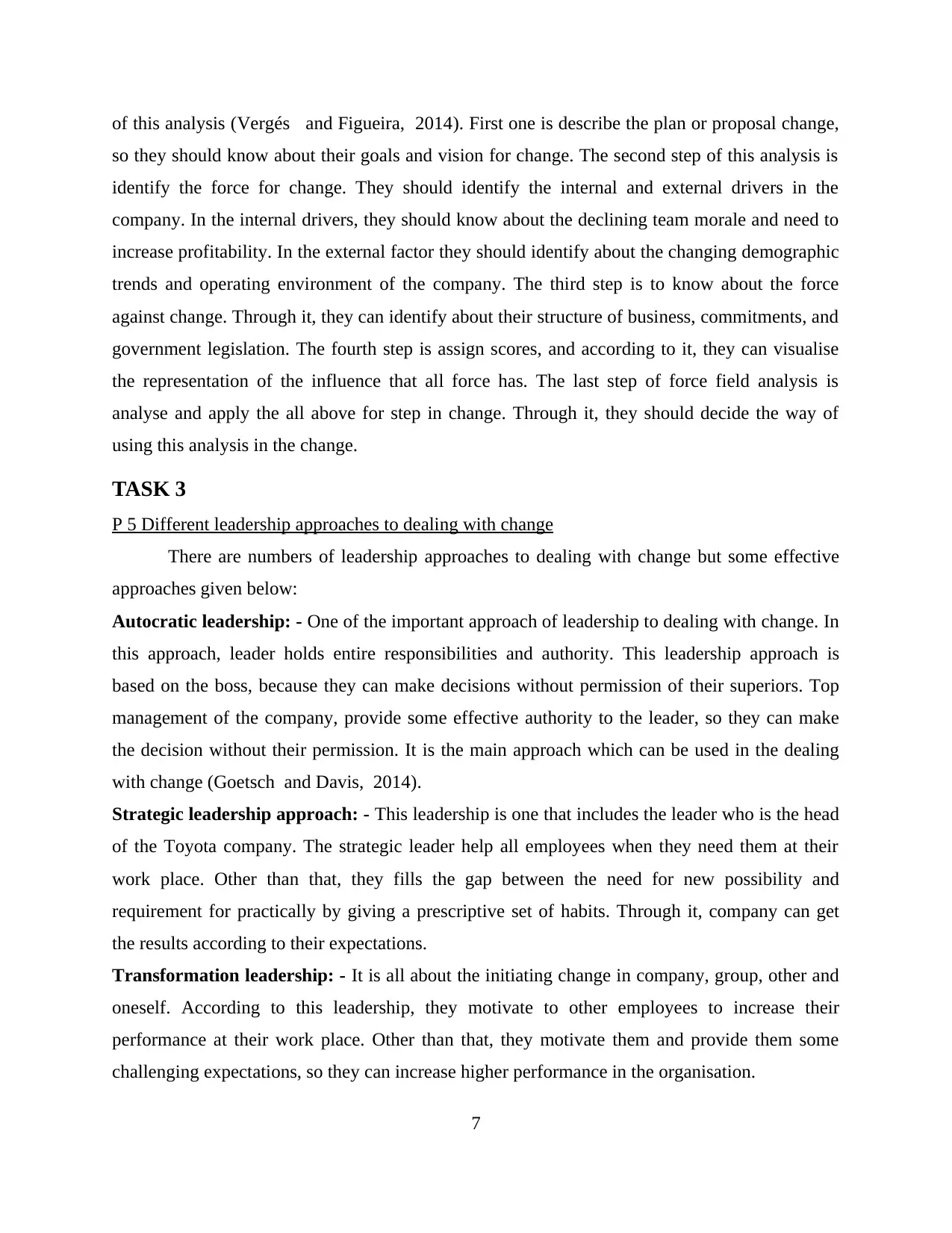
of this analysis (Vergés and Figueira, 2014). First one is describe the plan or proposal change,
so they should know about their goals and vision for change. The second step of this analysis is
identify the force for change. They should identify the internal and external drivers in the
company. In the internal drivers, they should know about the declining team morale and need to
increase profitability. In the external factor they should identify about the changing demographic
trends and operating environment of the company. The third step is to know about the force
against change. Through it, they can identify about their structure of business, commitments, and
government legislation. The fourth step is assign scores, and according to it, they can visualise
the representation of the influence that all force has. The last step of force field analysis is
analyse and apply the all above for step in change. Through it, they should decide the way of
using this analysis in the change.
TASK 3
P 5 Different leadership approaches to dealing with change
There are numbers of leadership approaches to dealing with change but some effective
approaches given below:
Autocratic leadership: - One of the important approach of leadership to dealing with change. In
this approach, leader holds entire responsibilities and authority. This leadership approach is
based on the boss, because they can make decisions without permission of their superiors. Top
management of the company, provide some effective authority to the leader, so they can make
the decision without their permission. It is the main approach which can be used in the dealing
with change (Goetsch and Davis, 2014).
Strategic leadership approach: - This leadership is one that includes the leader who is the head
of the Toyota company. The strategic leader help all employees when they need them at their
work place. Other than that, they fills the gap between the need for new possibility and
requirement for practically by giving a prescriptive set of habits. Through it, company can get
the results according to their expectations.
Transformation leadership: - It is all about the initiating change in company, group, other and
oneself. According to this leadership, they motivate to other employees to increase their
performance at their work place. Other than that, they motivate them and provide them some
challenging expectations, so they can increase higher performance in the organisation.
7
so they should know about their goals and vision for change. The second step of this analysis is
identify the force for change. They should identify the internal and external drivers in the
company. In the internal drivers, they should know about the declining team morale and need to
increase profitability. In the external factor they should identify about the changing demographic
trends and operating environment of the company. The third step is to know about the force
against change. Through it, they can identify about their structure of business, commitments, and
government legislation. The fourth step is assign scores, and according to it, they can visualise
the representation of the influence that all force has. The last step of force field analysis is
analyse and apply the all above for step in change. Through it, they should decide the way of
using this analysis in the change.
TASK 3
P 5 Different leadership approaches to dealing with change
There are numbers of leadership approaches to dealing with change but some effective
approaches given below:
Autocratic leadership: - One of the important approach of leadership to dealing with change. In
this approach, leader holds entire responsibilities and authority. This leadership approach is
based on the boss, because they can make decisions without permission of their superiors. Top
management of the company, provide some effective authority to the leader, so they can make
the decision without their permission. It is the main approach which can be used in the dealing
with change (Goetsch and Davis, 2014).
Strategic leadership approach: - This leadership is one that includes the leader who is the head
of the Toyota company. The strategic leader help all employees when they need them at their
work place. Other than that, they fills the gap between the need for new possibility and
requirement for practically by giving a prescriptive set of habits. Through it, company can get
the results according to their expectations.
Transformation leadership: - It is all about the initiating change in company, group, other and
oneself. According to this leadership, they motivate to other employees to increase their
performance at their work place. Other than that, they motivate them and provide them some
challenging expectations, so they can increase higher performance in the organisation.
7
⊘ This is a preview!⊘
Do you want full access?
Subscribe today to unlock all pages.

Trusted by 1+ million students worldwide
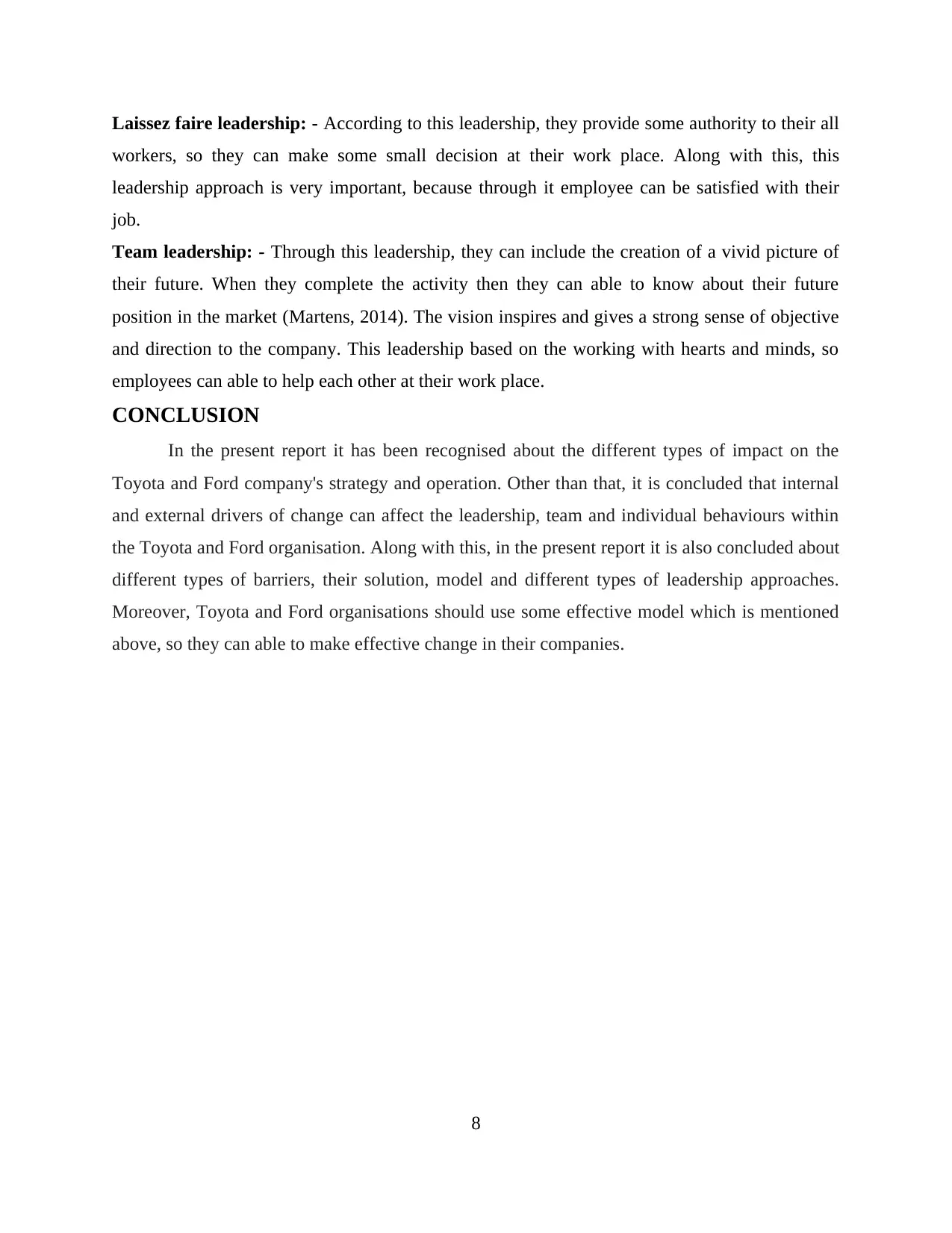
Laissez faire leadership: - According to this leadership, they provide some authority to their all
workers, so they can make some small decision at their work place. Along with this, this
leadership approach is very important, because through it employee can be satisfied with their
job.
Team leadership: - Through this leadership, they can include the creation of a vivid picture of
their future. When they complete the activity then they can able to know about their future
position in the market (Martens, 2014). The vision inspires and gives a strong sense of objective
and direction to the company. This leadership based on the working with hearts and minds, so
employees can able to help each other at their work place.
CONCLUSION
In the present report it has been recognised about the different types of impact on the
Toyota and Ford company's strategy and operation. Other than that, it is concluded that internal
and external drivers of change can affect the leadership, team and individual behaviours within
the Toyota and Ford organisation. Along with this, in the present report it is also concluded about
different types of barriers, their solution, model and different types of leadership approaches.
Moreover, Toyota and Ford organisations should use some effective model which is mentioned
above, so they can able to make effective change in their companies.
8
workers, so they can make some small decision at their work place. Along with this, this
leadership approach is very important, because through it employee can be satisfied with their
job.
Team leadership: - Through this leadership, they can include the creation of a vivid picture of
their future. When they complete the activity then they can able to know about their future
position in the market (Martens, 2014). The vision inspires and gives a strong sense of objective
and direction to the company. This leadership based on the working with hearts and minds, so
employees can able to help each other at their work place.
CONCLUSION
In the present report it has been recognised about the different types of impact on the
Toyota and Ford company's strategy and operation. Other than that, it is concluded that internal
and external drivers of change can affect the leadership, team and individual behaviours within
the Toyota and Ford organisation. Along with this, in the present report it is also concluded about
different types of barriers, their solution, model and different types of leadership approaches.
Moreover, Toyota and Ford organisations should use some effective model which is mentioned
above, so they can able to make effective change in their companies.
8
Paraphrase This Document
Need a fresh take? Get an instant paraphrase of this document with our AI Paraphraser
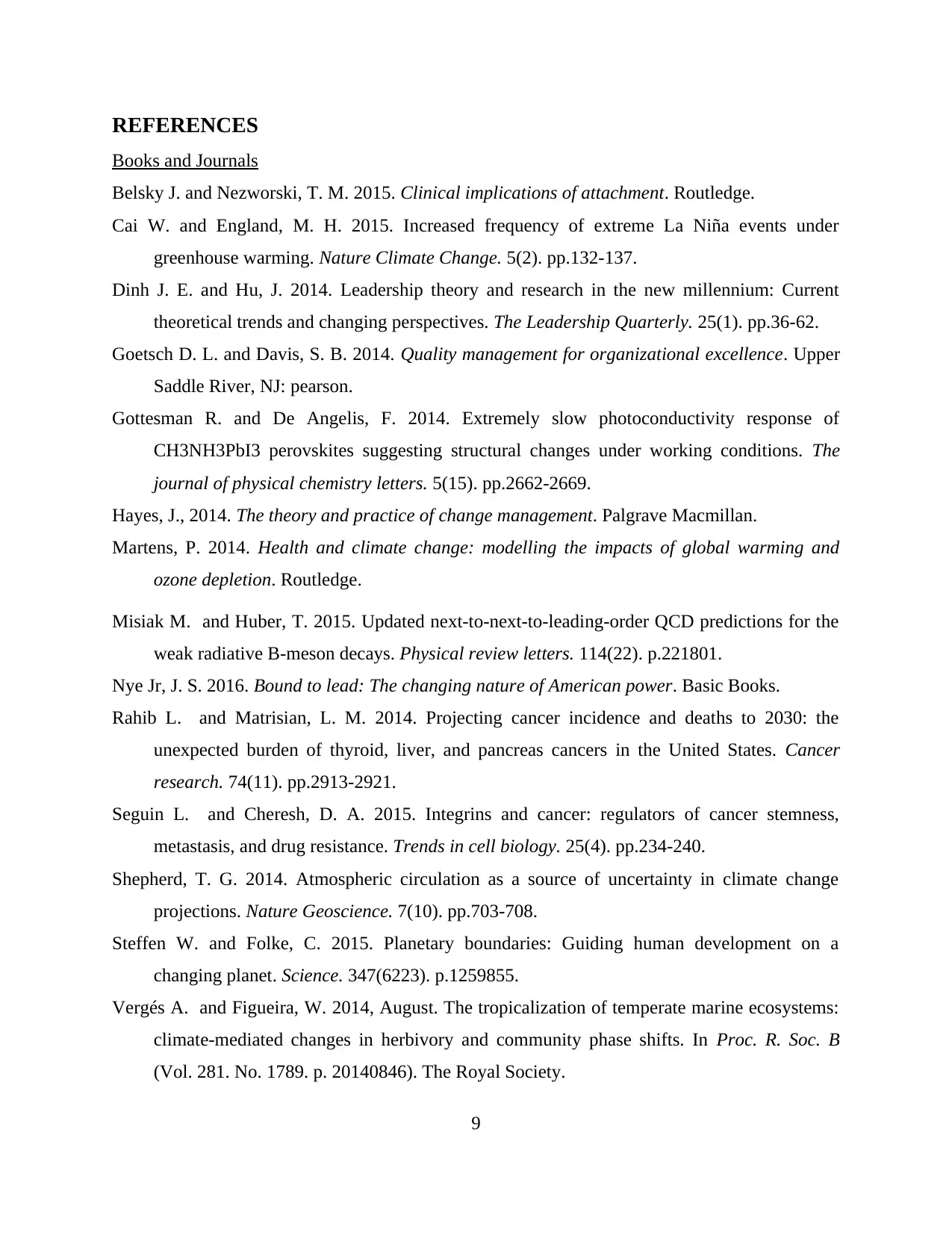
REFERENCES
Books and Journals
Belsky J. and Nezworski, T. M. 2015. Clinical implications of attachment. Routledge.
Cai W. and England, M. H. 2015. Increased frequency of extreme La Niña events under
greenhouse warming. Nature Climate Change. 5(2). pp.132-137.
Dinh J. E. and Hu, J. 2014. Leadership theory and research in the new millennium: Current
theoretical trends and changing perspectives. The Leadership Quarterly. 25(1). pp.36-62.
Goetsch D. L. and Davis, S. B. 2014. Quality management for organizational excellence. Upper
Saddle River, NJ: pearson.
Gottesman R. and De Angelis, F. 2014. Extremely slow photoconductivity response of
CH3NH3PbI3 perovskites suggesting structural changes under working conditions. The
journal of physical chemistry letters. 5(15). pp.2662-2669.
Hayes, J., 2014. The theory and practice of change management. Palgrave Macmillan.
Martens, P. 2014. Health and climate change: modelling the impacts of global warming and
ozone depletion. Routledge.
Misiak M. and Huber, T. 2015. Updated next-to-next-to-leading-order QCD predictions for the
weak radiative B-meson decays. Physical review letters. 114(22). p.221801.
Nye Jr, J. S. 2016. Bound to lead: The changing nature of American power. Basic Books.
Rahib L. and Matrisian, L. M. 2014. Projecting cancer incidence and deaths to 2030: the
unexpected burden of thyroid, liver, and pancreas cancers in the United States. Cancer
research. 74(11). pp.2913-2921.
Seguin L. and Cheresh, D. A. 2015. Integrins and cancer: regulators of cancer stemness,
metastasis, and drug resistance. Trends in cell biology. 25(4). pp.234-240.
Shepherd, T. G. 2014. Atmospheric circulation as a source of uncertainty in climate change
projections. Nature Geoscience. 7(10). pp.703-708.
Steffen W. and Folke, C. 2015. Planetary boundaries: Guiding human development on a
changing planet. Science. 347(6223). p.1259855.
Vergés A. and Figueira, W. 2014, August. The tropicalization of temperate marine ecosystems:
climate-mediated changes in herbivory and community phase shifts. In Proc. R. Soc. B
(Vol. 281. No. 1789. p. 20140846). The Royal Society.
9
Books and Journals
Belsky J. and Nezworski, T. M. 2015. Clinical implications of attachment. Routledge.
Cai W. and England, M. H. 2015. Increased frequency of extreme La Niña events under
greenhouse warming. Nature Climate Change. 5(2). pp.132-137.
Dinh J. E. and Hu, J. 2014. Leadership theory and research in the new millennium: Current
theoretical trends and changing perspectives. The Leadership Quarterly. 25(1). pp.36-62.
Goetsch D. L. and Davis, S. B. 2014. Quality management for organizational excellence. Upper
Saddle River, NJ: pearson.
Gottesman R. and De Angelis, F. 2014. Extremely slow photoconductivity response of
CH3NH3PbI3 perovskites suggesting structural changes under working conditions. The
journal of physical chemistry letters. 5(15). pp.2662-2669.
Hayes, J., 2014. The theory and practice of change management. Palgrave Macmillan.
Martens, P. 2014. Health and climate change: modelling the impacts of global warming and
ozone depletion. Routledge.
Misiak M. and Huber, T. 2015. Updated next-to-next-to-leading-order QCD predictions for the
weak radiative B-meson decays. Physical review letters. 114(22). p.221801.
Nye Jr, J. S. 2016. Bound to lead: The changing nature of American power. Basic Books.
Rahib L. and Matrisian, L. M. 2014. Projecting cancer incidence and deaths to 2030: the
unexpected burden of thyroid, liver, and pancreas cancers in the United States. Cancer
research. 74(11). pp.2913-2921.
Seguin L. and Cheresh, D. A. 2015. Integrins and cancer: regulators of cancer stemness,
metastasis, and drug resistance. Trends in cell biology. 25(4). pp.234-240.
Shepherd, T. G. 2014. Atmospheric circulation as a source of uncertainty in climate change
projections. Nature Geoscience. 7(10). pp.703-708.
Steffen W. and Folke, C. 2015. Planetary boundaries: Guiding human development on a
changing planet. Science. 347(6223). p.1259855.
Vergés A. and Figueira, W. 2014, August. The tropicalization of temperate marine ecosystems:
climate-mediated changes in herbivory and community phase shifts. In Proc. R. Soc. B
(Vol. 281. No. 1789. p. 20140846). The Royal Society.
9
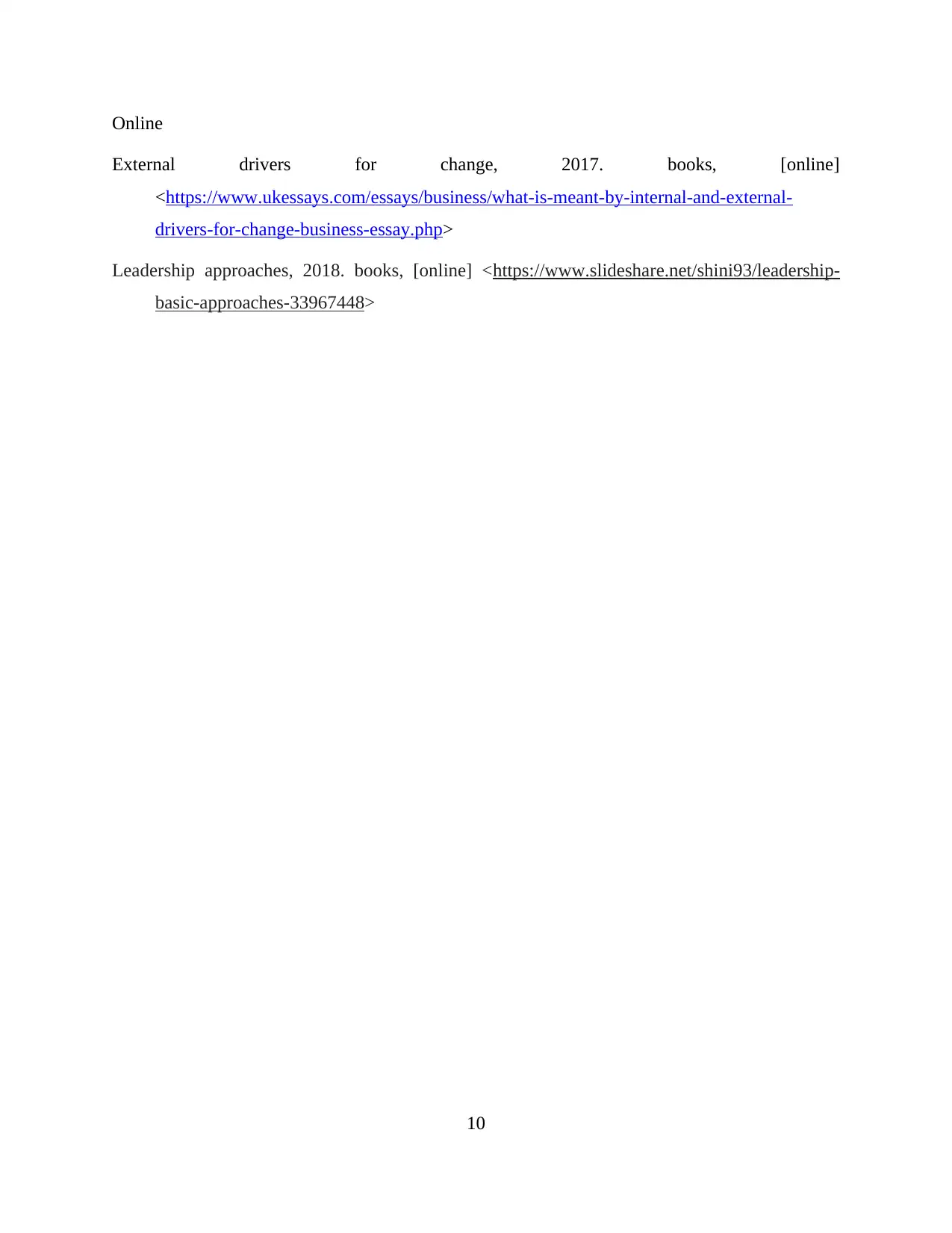
Online
External drivers for change, 2017. books, [online]
<https://www.ukessays.com/essays/business/what-is-meant-by-internal-and-external-
drivers-for-change-business-essay.php>
Leadership approaches, 2018. books, [online] <https://www.slideshare.net/shini93/leadership-
basic-approaches-33967448>
10
External drivers for change, 2017. books, [online]
<https://www.ukessays.com/essays/business/what-is-meant-by-internal-and-external-
drivers-for-change-business-essay.php>
Leadership approaches, 2018. books, [online] <https://www.slideshare.net/shini93/leadership-
basic-approaches-33967448>
10
⊘ This is a preview!⊘
Do you want full access?
Subscribe today to unlock all pages.

Trusted by 1+ million students worldwide
1 out of 12
Related Documents
Your All-in-One AI-Powered Toolkit for Academic Success.
+13062052269
info@desklib.com
Available 24*7 on WhatsApp / Email
![[object Object]](/_next/static/media/star-bottom.7253800d.svg)
Unlock your academic potential
Copyright © 2020–2025 A2Z Services. All Rights Reserved. Developed and managed by ZUCOL.





